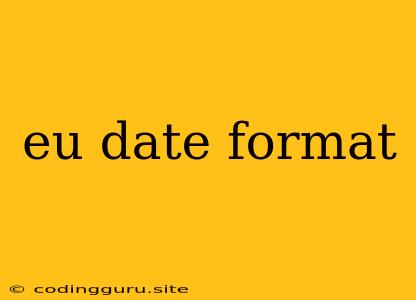Navigating the Labyrinth of European Date Formats: A Guide to Understanding and Using them
The European Union (EU) is a diverse collection of nations, each with its own unique culture and traditions. This diversity extends to the way dates are written, which can often be a source of confusion for those outside the region. Understanding the common EU date formats is crucial for effective communication and avoiding misunderstandings.
Why are EU date formats different?
The primary reason for the differing formats stems from cultural and historical influences. Unlike the US, which predominantly uses the month-day-year format (MM/DD/YYYY), many European countries favor the day-month-year (DD/MM/YYYY) format. This preference is rooted in the historical development of writing systems and the emphasis on the order of importance of the date elements.
Common EU Date Formats:
While the day-month-year (DD/MM/YYYY) format is prevalent across the EU, some countries employ variations on this theme. Here's a brief overview:
-
DD/MM/YYYY: This format is the most common, used in countries like the United Kingdom, France, Germany, Spain, and Italy. It prioritizes the day of the month followed by the month and then the year.
-
DD.MM.YYYY: Some countries, like Austria and Switzerland, utilize a dot (.) as the separator between the date elements. This format maintains the day-month-year order but employs a distinct delimiter.
-
DD-MM-YYYY: Another variation is the use of a hyphen (-) as the separator, as seen in countries like Finland and Sweden. This format continues to prioritize the day of the month.
Understanding the Importance of Context:
When dealing with EU date formats, it's crucial to remember that context plays a vital role. If you are presented with a date without any additional information, it's best to assume the day-month-year format. However, if you are provided with further context, like a country name or a specific document, it can help you determine the correct date format.
Tips for Avoiding Misunderstandings:
-
Be explicit: When communicating dates, especially in formal contexts, always use the full date format (e.g., 20 March 2024) or specify the format explicitly (e.g., "20/03/2024 (DD/MM/YYYY)").
-
Use digital tools: Many online calendars, date converters, and spreadsheet programs can automatically convert between different date formats.
-
Be aware of regional variations: While the day-month-year format is prevalent across the EU, some countries have specific regional preferences.
Example Scenarios:
Imagine you are a businessperson scheduling a meeting with a client in Germany. You receive an email with a proposed date of "15.04.2024." Knowing that Germany uses the DD.MM.YYYY format, you can confidently conclude that the meeting is on April 15th, 2024.
Conclusion:
Navigating the EU date formats requires an awareness of cultural differences and a keen eye for context. By understanding the common formats and employing best practices for communication, you can avoid confusion and ensure clarity in your interactions with European partners. Always remember that clear communication is paramount in any intercultural exchange.
